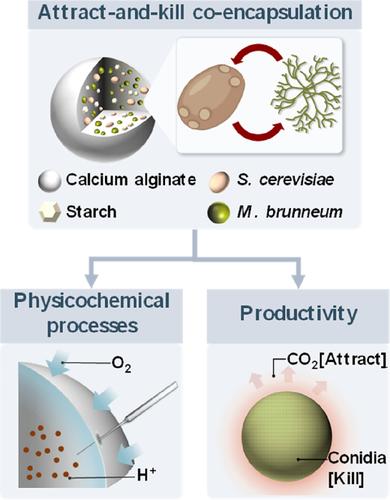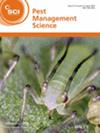求助PDF
{"title":"揭示褐藻酵母菌和布鲁氏菌在海藻酸钙吸附杀灭珠中的相互作用。","authors":"Katharina M Hermann, Alexander Grünberger, Anant V Patel","doi":"10.1002/ps.8238","DOIUrl":null,"url":null,"abstract":"<p><strong>Background: </strong>Attract-and-kill (AK) beads are biological, microbial insecticides developed as an alternative to synthetic soil insecticides. For wireworm control, beads are based on calcium alginate/starch co-encapsulating the carbon dioxide (CO<sub>2</sub>) producing yeast Saccharomyces cerevisiae H205 as the attract component, and the entomopathogenic fungus Metarhizium brunneum CB15-III as the kill component. However, the physicochemical processes inside beads during co-cultivation are still unclear. Here we reveal for the first time the spatiotemporal conditions of oxygen and pH inside AK beads measured with microelectrodes and describe the impact of S. cerevisiae on CO<sub>2</sub> and conidia formation.</p><p><strong>Results: </strong>Measurements revealed a steep oxygen gradient already 2 days after co-encapsulation, with an internal hypoxic zone. Encapsulating either S. cerevisiae or M. brunneum already decreased the average pH from 5.5 to 4.7 and 4.6, respectively. However, on day 3, co-cultivation lead to temporal strong acidification of beads down to pH 3.6 which followed the maximum CO<sub>2</sub> productivity and coincided with the maximum conidiation rate. Decreasing the yeast load decreased the total CO<sub>2</sub> productivity to half, and the conidial production by 93%, while specific productivities normalized to 1% yeast load increased eight-fold and three-fold, respectively, with day 3 being an exception.</p><p><strong>Conclusion: </strong>Our findings indicate a general beneficial interaction between M. brunneum and S. cerevisiae, but also suggest competition for resources. These findings will contribute to develop innovative co-formulations with maximum efficiency to save application rates and costs. © 2024 The Author(s). Pest Management Science published by John Wiley & Sons Ltd on behalf of Society of Chemical Industry.</p>","PeriodicalId":218,"journal":{"name":"Pest Management Science","volume":null,"pages":null},"PeriodicalIF":3.8000,"publicationDate":"2024-06-12","publicationTypes":"Journal Article","fieldsOfStudy":null,"isOpenAccess":false,"openAccessPdf":"","citationCount":"0","resultStr":"{\"title\":\"Unraveling the interaction of co-encapsulated Saccharomyces cerevisiae and Metarhizium brunneum in calcium alginate-based attract-and-kill beads.\",\"authors\":\"Katharina M Hermann, Alexander Grünberger, Anant V Patel\",\"doi\":\"10.1002/ps.8238\",\"DOIUrl\":null,\"url\":null,\"abstract\":\"<p><strong>Background: </strong>Attract-and-kill (AK) beads are biological, microbial insecticides developed as an alternative to synthetic soil insecticides. For wireworm control, beads are based on calcium alginate/starch co-encapsulating the carbon dioxide (CO<sub>2</sub>) producing yeast Saccharomyces cerevisiae H205 as the attract component, and the entomopathogenic fungus Metarhizium brunneum CB15-III as the kill component. However, the physicochemical processes inside beads during co-cultivation are still unclear. Here we reveal for the first time the spatiotemporal conditions of oxygen and pH inside AK beads measured with microelectrodes and describe the impact of S. cerevisiae on CO<sub>2</sub> and conidia formation.</p><p><strong>Results: </strong>Measurements revealed a steep oxygen gradient already 2 days after co-encapsulation, with an internal hypoxic zone. Encapsulating either S. cerevisiae or M. brunneum already decreased the average pH from 5.5 to 4.7 and 4.6, respectively. However, on day 3, co-cultivation lead to temporal strong acidification of beads down to pH 3.6 which followed the maximum CO<sub>2</sub> productivity and coincided with the maximum conidiation rate. Decreasing the yeast load decreased the total CO<sub>2</sub> productivity to half, and the conidial production by 93%, while specific productivities normalized to 1% yeast load increased eight-fold and three-fold, respectively, with day 3 being an exception.</p><p><strong>Conclusion: </strong>Our findings indicate a general beneficial interaction between M. brunneum and S. cerevisiae, but also suggest competition for resources. These findings will contribute to develop innovative co-formulations with maximum efficiency to save application rates and costs. © 2024 The Author(s). Pest Management Science published by John Wiley & Sons Ltd on behalf of Society of Chemical Industry.</p>\",\"PeriodicalId\":218,\"journal\":{\"name\":\"Pest Management Science\",\"volume\":null,\"pages\":null},\"PeriodicalIF\":3.8000,\"publicationDate\":\"2024-06-12\",\"publicationTypes\":\"Journal Article\",\"fieldsOfStudy\":null,\"isOpenAccess\":false,\"openAccessPdf\":\"\",\"citationCount\":\"0\",\"resultStr\":null,\"platform\":\"Semanticscholar\",\"paperid\":null,\"PeriodicalName\":\"Pest Management Science\",\"FirstCategoryId\":\"97\",\"ListUrlMain\":\"https://doi.org/10.1002/ps.8238\",\"RegionNum\":1,\"RegionCategory\":\"农林科学\",\"ArticlePicture\":[],\"TitleCN\":null,\"AbstractTextCN\":null,\"PMCID\":null,\"EPubDate\":\"\",\"PubModel\":\"\",\"JCR\":\"Q1\",\"JCRName\":\"AGRONOMY\",\"Score\":null,\"Total\":0}","platform":"Semanticscholar","paperid":null,"PeriodicalName":"Pest Management Science","FirstCategoryId":"97","ListUrlMain":"https://doi.org/10.1002/ps.8238","RegionNum":1,"RegionCategory":"农林科学","ArticlePicture":[],"TitleCN":null,"AbstractTextCN":null,"PMCID":null,"EPubDate":"","PubModel":"","JCR":"Q1","JCRName":"AGRONOMY","Score":null,"Total":0}
引用次数: 0
引用
批量引用
Unraveling the interaction of co-encapsulated Saccharomyces cerevisiae and Metarhizium brunneum in calcium alginate-based attract-and-kill beads.
Background: Attract-and-kill (AK) beads are biological, microbial insecticides developed as an alternative to synthetic soil insecticides. For wireworm control, beads are based on calcium alginate/starch co-encapsulating the carbon dioxide (CO2 ) producing yeast Saccharomyces cerevisiae H205 as the attract component, and the entomopathogenic fungus Metarhizium brunneum CB15-III as the kill component. However, the physicochemical processes inside beads during co-cultivation are still unclear. Here we reveal for the first time the spatiotemporal conditions of oxygen and pH inside AK beads measured with microelectrodes and describe the impact of S. cerevisiae on CO2 and conidia formation.
Results: Measurements revealed a steep oxygen gradient already 2 days after co-encapsulation, with an internal hypoxic zone. Encapsulating either S. cerevisiae or M. brunneum already decreased the average pH from 5.5 to 4.7 and 4.6, respectively. However, on day 3, co-cultivation lead to temporal strong acidification of beads down to pH 3.6 which followed the maximum CO2 productivity and coincided with the maximum conidiation rate. Decreasing the yeast load decreased the total CO2 productivity to half, and the conidial production by 93%, while specific productivities normalized to 1% yeast load increased eight-fold and three-fold, respectively, with day 3 being an exception.
Conclusion: Our findings indicate a general beneficial interaction between M. brunneum and S. cerevisiae, but also suggest competition for resources. These findings will contribute to develop innovative co-formulations with maximum efficiency to save application rates and costs. © 2024 The Author(s). Pest Management Science published by John Wiley & Sons Ltd on behalf of Society of Chemical Industry.



